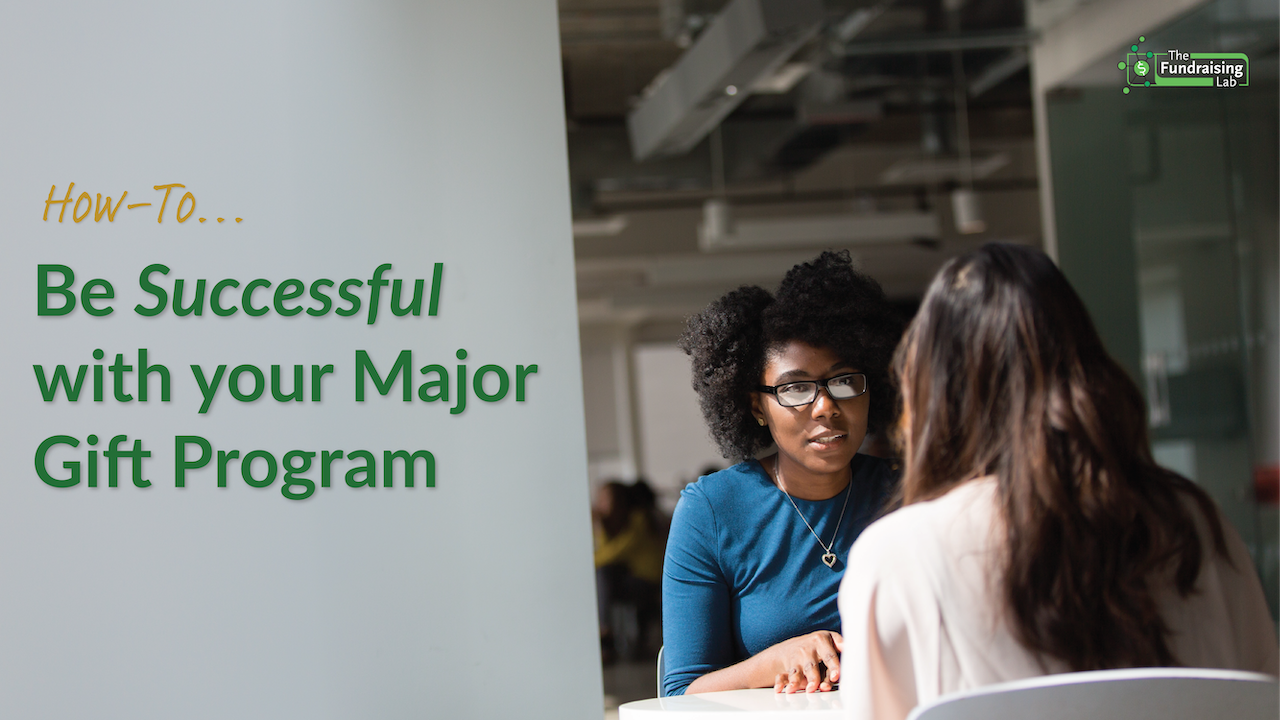How to Be Successful with your Major Gift Program

It’s easy, they say.
I’ll just wing it, they say.
I know the donor, they say.
They say…is not what we say.
There are several things you need to put into place to be successful with major gifts…especially if you’re a small shop and it’s either a one-person show or a small team.
We’re going to provide some direction so you can run a solid program…because the better you are at major gifts, the more money you bring into your organization and that’s a good thing!
Here are two key initiatives you need to focus on to achieve your yearly fundraising goals (drum roll, please…):
- Plan
- Know What You’re Asking Donors For
Well, that seems like a piece of cake (yuuummm, cake).

But for you to have your cake and eat it too (oh yes, I said it), we need to expand a bit on each…
Plan
If you haven’t established a one-to-one major giving program, figure out if you have the resources to start one.
First stop…your donor database.
Do you have individual donors that are giving more than $1,000 per year – either through a one-time gift or monthly donations?
Do you have any? Do you have many?
Check also to see if you have donors who are giving more than $10,000 per year.
“Yes, I have donors that are giving more than that!”
Well, that’s great!
If you have donors who are giving in the $10,000 to $25,000 range as major donors, you may be able to make the case that you can invest the time to reach out to them individually and dedicate one full-time person to this job.
Bear with me even if you don’t fall into this camp.
I’m about to walk you through an interesting thought experiment.
Do the math…if you:
- can reach 25 donors at $10,000 each, that’s $250,000 in one year.
- have 25 donors at $25,000 each, that’s $625,000.
- have some at the $10,000 level and some at the $25,000 level, that’s between $250,000 and $625,000.
And that’s worth developing an individualized approach.
But be clear on what your plan is and where those prospective donors are coming from.
At that range, you’ll need to have between 4 and 10 times as many prospective donors as you need to have donors in the end for you to reach your goal.
So, if you need to secure 25 donors at between $10,000 and $25,000, you’ll need to identify somewhere between 100 and 250 prospective donors (4 to 10 times as many donors) …
with the capacity to give that amount …
and have a plan to reach out to them, nurture the relationship and ask for and receive a gift within one year to get to the kind of numbers we’re talking about.
This is why planning is so important.
Know What You’re Asking Donors For
Do you have a big, hairy audacious goal that you want donors to be part of?
Human nature and our way of fundraising lead donors who give bigger sums of money to want to know exactly where their donor dollars are being spent. They have become accustomed to expecting that a larger donation will be for a specific program or service.
Do you have a bunch of those that you can list?
Times are changing and we are seeing some donors give to whatever is needed most. We saw this during the pandemic. Donors recognized there was a need and they gave freely without needing to know the details of where exactly it was going.
We need to figure out how to keep that going…if we can keep it going.
But donors will most likely go back to the old ways of wanting to support a program.
So…
- What programs need funding?
- What are your organization’s most pressing issues?
- Is it a new program or a tried and true?
This is where the program folks come in. Set up meetings if you’re not clear on where the organization needs help.
Walk away with knowing exactly how the program runs, how it helps your base, what outcomes you’ll see with the extra funding and why it is needed right now!
A major gifts program takes multiple steps to get right. And that’s why next week, we’re going to expand on today’s blog to provide you with a more in-depth look at what is required to run a successful program.
Because a successful program brings in more donations. And our organizations need more of that.
See you on the flip side,
Cathy Mann and the team at Fundraising Lab
P.S. Want to get access to free fundraising resources? Check out our guides: https://www.fundraisinglab.ca/guides

